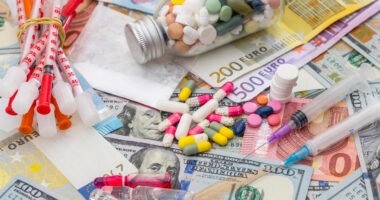Biosimilars: Opportunities and Challenges in the US and EU
Policymakers and the biopharmaceutical industry have been discussing the opportunity of biosimilars for more than a decade, but where do biosimilars stand today?
The opportunities loom larger than ever today, with about $100 billion worth of biologics set to lose patent protection in Europe and the United States over the next few years, according to a Clarivate report, Biosimilars: Opportunities and Challenges in the EU, U.S. and Russia. In the US alone, more than 70 biologics are expected to be off patent by 2021, according to the Clarivate report.
Biosimilars: US market
 |
|
Mari Serebrov, |
Much of the interest in biosimilars relates to potential savings that they could offer. The reality of those savings differs from market to market with the US still waiting to see a significant impact. As of December 31, 2017, the US Food and Drug Administration (FDA) had approved nine biosimilars, but only three have launched: Sandoz Inc.’s Zarxio, referencing Amgen’s Neupogen (filgrastim), and two biosimilars referencing Johnson & Johnson’s (J&J) Remicade (infliximab). The others are waiting for key patents to expire or be litigated before they enter the US market (see Table I ).
| Table I: Biosimilars Approved by the US Food and Drug Administration as of December 31, 2017. | ||||||
| Brand name | International nonproprietary name (INN) | Sponsor | Reference product | Reference sponsor | Date approved | Date launched |
| Zarxio | filgrastim-sndz | Sandoz | Neupogen | Amgen | March 2015 | September 2016 |
| Inflectra | infliximab-dyyb | Celltrion (licensed to Pfizer) | Remicade | Janssen Biotech | April 2016 | November 2016 |
| Ereliz | etanercept-szzs | Sandoz | Enbrel | Amgen | August 2016 | Awaiting patent expiration |
| Amjevita | adalimumab-attp | Amgen | Humira | Abbvie | September 2016 | Settlement allows launch January 31, 2023 |
| Renflexis | infliximab-abda | Samsung Bioepis (licensed to Merck & Co. Inc.) | Remicade | Janssen Biotech | April 2017 | July 2017 |
| Cyltezo | adalimumab-adbm | Boehringer Ingelheim | Humira | AbbVie | August 2017 | Awaiting patent expiration |
| Mvasi | bevacizumab-awwb | Amgen/ Allergan |
Avastin | Roche | September 2017 | Awaiting patent expiration |
| Ogivri | trastuzumab-dkst | Mylan/ Biocon |
Herceptin | Roche | December 2017 | Awaiting date in confidential agreement with Roche |
| Ixifi | infliximab-qbtx | Pfizer | Remicade | Janssen Biotech | December 2017 | No launch date set |
|
Source: US Food and Drug Administration, company reports |
||||||
The first two biosimilars launched in the US—Zarxio and Inflectra, the first FDA-approved infliximab biosimilar—offered a 15% discount from the innovators’ list price, according to 2017 Trends in Biosimilars, a report by Amgen. A few drugs that were approved elsewhere as biosimilars, such as Sandoz’s Omnitrope (somatropin), which was approved in the US in 2006, and Eli Lilly and Company’s Basaglar (insulin glargine), which was approved in the US in 2015, came to the US market as drugs approved under the 505(b)(2) pathway and they, too, offered approximately a 15% discount at launch, according to the Clarivate report. A 505(b)(2) new drug application is a pathway created by the Hatch-Waxman Amendments of 1984, with 505(b)(2) referring to a section of the Federal Food, Drug, and Cosmetic Act. It relies to some extent on data from an approved drug and can be used for changes in dosage form, strength, route of administration, formulation, dosing regimen, or new indication.
Samsung Bioepis, a joint venture between Samsung BioLogics, a contract biologics manufacturer, and Biogen for biosimilar development, and Merck & Co. launched Renflexis in July 2017 as the second infliximab biosimilar in the US at a list price 35% below that of the reference product, Remicade, according to the Clarivate report.
Although the US market is just beginning to form, its size makes it critical to the success of biosimilars, such as Inflectra. The US accounts for 59% of the global infliximab market, according to the Clarivate report. The next largest share is Canada with 8.4% and then Japan with 7.1%.
Inflectra, a biosimilar of J&J’s Remicade (infliximab), is manufactured by Celltrion, based in Yeonsu-gu, Incheon, Republic of Korea, for Pfizer through its subsidiary, Hospira, which Pfizer acquired in September 2015 for $17 billion. In 2009, Hospira and Celltrion formed a pact for developing biosimilars, including Inflectra. Pfizer holds exclusive commercialization rights to Inflectra in the US and certain other jurisdictions. The FDA approved Inflectra from Hospira and Celltrion in April 2016.
In December 2017, the FDA also approved Pfizer’s Ixifi (infliximab-qbtx) as a biosimilar to J&J’s Remicade (infliximab) for all eligible indications of the reference product. The product has not launched. In February 2016, Sandoz, the generics arm of Novartis, acquired the rights for the development and commercialization of Ixifi in the European Economic Area, which includes the 28 member states of the European Union plus Iceland, Liechtenstein, and Norway. Sandoz acquired the rights to infliximab (i.e., the active pharmaceutical ingredient in Ixifi) as part of Pfizer satisfying requirements from the European Commission to divest the product in connection with its acquisition of Hospira.
Biosimilars: EU market
To succeed in the US, many companies are looking at how the biosimilar market developed in the European Union (EU), which was the first to establish a regulatory pathway for follow-on biologics. With nearly 40 biosimilars authorized as of December 31, 2017 (see Table II), the EU is seeing discounts averaging about 30%. Tender bidding and competition among multiple biosimilars have led to steeper discounts in some countries.
| Table II: Biosimilars approved by the European Medicines Agency as of December 31, 2017 | |||
| Reference biologic | International nonproprietary name (INN) | Reference sponsor | |
| Genotropin | somatropin | Pfizer Ltd. | |
| Biosimilar | Marketing authorization holder | Date approved | |
| Omnitrope | Sandoz GmbH (part of Novartis AG) | April 2006 | |
| Valtropin (withdrawn for commercial reasons) | BioPartners GmbH | April 2006 | |
| Reference biologic | International nonproprietary name (INN) | Reference sponsor | |
| Eprex/Erypo | epoetin alfa | Janssen-Cilag GmbH | |
| Biosimilar | Marketing authorization holder | Date approved | |
| Abseamed | Medice Arzneimittel Pütter GmbH & Co KG | August 2007 | |
| Binocrit | Sandoz GmbH (part of Novartis AG) | August 2007 | |
| Epoetin Alfa Hexal | Hexal AG (part of Novartis AG) | August 2007 | |
| Retacrit (assigned epoetin zeta as INN) |
Hospira UK (now part of Pfizer) | December 2007 | |
|
Silapo |
Stada Arzneimittel AG | December 2007 | |
| Reference biologic | International nonproprietary name (INN) | Reference sponsor | |
| Neupogen | filgrastim | Amgen Europe BV | |
| Biosimilar | Marketing authorization holder | Date approved | |
| Ratiograstim | Ratiopharm GmbH (now part of Teva Pharmaceutical Industries) | September 2008 | |
| Tevagrastim | Teva GmbH | September 2008 | |
| Biograstim (withdrawn for commercial reasons) | AbZ Pharma GmbH | September 2008 | |
| Filgrastim ratiopharm (withdrawn for commercial reasons) | Ratiopharm GmbH (now part of Teva Pharmaceutical Industries) | September 2008 | |
| Filgrastim Hexal | Hexal AG (part of Novartis AG) | February 2009 | |
| Zarzio | Sandoz GmbH (part of Novartis AG) | February 2009 | |
| Nivestim | Hospira UK Ltd. (now part of Pfizer Inc.) | June 2010 | |
| Grastofil | Apotex Europe BV | October 2013 | |
| Accofil | Accord Healthcare Ltd. | September 2014 | |
| Flixabi | Samsung Bioepis UK Ltd. | May 2016 | |
| Reference biologic | International nonproprietary name (INN) | Reference sponsor | |
| Remicade | infliximab | Janssen Biologics BV | |
| Biosimilar | Marketing authorization holder | Date approved | |
| Inflectra | Hospira UK Ltd. (now part of Pfizer Inc.) (licensed from Celltrion Healthcare Hungary Kft) | September 2013 | |
| Remsima | Celltrion Healthcare Hungary Kft. | September 2013 | |
| Flixabi | Samsung Bioepis UK Ltd. | May 2016 | |
| Reference biologic | International nonproprietary name (INN) | Reference sponsor | |
| Gonal-F | follitropin alfa | Merck Serono Europe Ltd. | |
| Biosimilar | Marketing authorization holder | Date approved | |
| Ovaleap | Teva Pharma BV | September 2013 | |
| Bemfola | Gedeon Richter plc | March 2014 | |
| Reference biologic | International nonproprietary name (INN) | Reference sponsor | |
| Lantus | insulin glargine | Sanofi-Aventis Deutschland GmbH | |
| Biosimilar | Marketing authorization holder | Date approved | |
| Abasaglar | Eli Lilly Regional Operations GmbH | September 2014 | |
| Lusduna | Merck Sharp & Dohme Ltd. (partnered with Samsung Bioepis) | January 2017 | |
| Reference biologic | International nonproprietary name (INN) | Reference sponsor | |
| Enbrel | etanercept | Pfizer Ltd. | |
| Biosimilar | Marketing authorization holder | Date approved | |
| Benepali | Samsung Bioepis UK Ltd. | January 2016 | |
| Erelzi | Sandoz GmbH (part of Novartis AG) | June 2017 | |
| Reference biologic | International nonproprietary name (INN) | Reference sponsor | |
| Clexane | enoxaparin | Sanofi-Aventis Deutschland GmbH | |
| Biosimilar | Marketing authorization holder | Date approved | |
| Inhixa | Techdow Europe AB (part of Shenzhen Techdow Pharmaceutical Co.) | September 2016 | |
| Thorinane | Pharmathen SA | September 2016 | |
| Reference biologic | International nonproprietary name (INN) | Reference sponsor | |
| Forsteo | teriparatide | Eli Lilly Nederland BV | |
| Biosimilar | Marketing authorization holder | Date approved | |
| Movymia | Stada Arzneimittel AG | January 2017 | |
| Terrosa | Gedeon Richter plc | January 2017 | |
| Reference biologic | International nonproprietary name (INN) | Reference sponsor | |
| Mabthera | rituximab | Roche Registration Ltd. | |
| Biosimilar | Marketing authorization holder | Date approved | |
| Truxima | Celltrion Healthcare Hungary Kft. | February 2017 | |
| Rixathon | Sandoz GmbH (part of Novartis AG) | June 2017 | |
| Riximyo | Sandoz GmbH (part of Novartis AG) | June 2017 | |
| Blitzima | Celltrion Healthcare Hungary Kft. | July 2017 | |
| Ritemvia | Celltrion Healthcare Hungary Kft. | July 2017 | |
| Rituzena | Celltrion Healthcare Hungary Kft. | July 2017 | |
| Reference biologic | International nonproprietary name (INN) | Reference sponsor | |
| Humira | adalimumab | AbbVie Ltd. | |
| Biosimilar | Marketing authorization holder | Date approved | |
| Amgevita | Amgen Europe BV | March 2017 | |
| Solymbic | Amgen Europe BV | March 2017 | |
| Imraldi | Samsung Bioepis UK | August 2017 | |
| Cyltezo | Boehringer Ingelheim International GmbH | November 2017 | |
| Reference biologic | International nonproprietary name (INN) | Reference sponsor | |
| Humalog | insulin lispro | Eli Lilly Nederland BV | |
| Biosimilar | Marketing authorization holder | Date approved | |
| Insulin lispro Sanofi | Sanofi-Aventis Groupe | July 2017 | |
|
*Source: European Medicines Agency |
|||
Price discounts impact the uptake of biosimilar use. For example, in Romania, a 62% drop in the list price of filgrastim in 2016 compared with the year the first biosimilar launched led to a 2,542% increase of use by volume, according to a report, The Impact of Biosimilar Competition in Europe, compiled by the market research firm, IQVIA (formerly QuintilesIMS), for the European Commission. The report describes the effects on price, volume, and market share following the arrival and presence of biosimilar competition in the European Economic Area. A 61% drop in the price of filgrastim in Slovakia pushed use up by 509%. And in Norway, where filgrastim was widely used before biosimilars were available, the follow-ons boosted volume by 164%. The impact is not limited to the reference biologic as the discounted follow-ons pressure the pricing of all biologics in the class while increasing their use.
The EU experience may not directly translate to the US. Driven by patent expiry and demand, filgrastim and epoetin biosimilars were among the first to come to the EU market. The European Medicines Agency approved five epoetin biosimilars in 2007 and nine referencing Neupogen between 2008–2014. Today, the interest in new biosimilars in the EU is focused on monoclonal antibodies (mAbs) and insulin products. In the US, all but one of the approved biosimilars reference blockbuster mAbs as does much of the disclosed biosimilar pipeline. Approval in the US for epoetin and filgrastim biosimilars has been limited to date with the FDA approving only one filgrastim biosimilar, Sandoz’s Zarxio. An FDA advisory committee recommended approval of Pfizer’s epoetin alfa biosimilar, Retacrit, in May 2017, which the EMA had authorized in 2007, but the FDA subsequently issued a Complete Response Letter in June 2017, citing manufacturing issues at Pfizer’s manufacturing facility in McPherson, Kansas, which was the facility listed as the potential manufacturing site for the proposed epoetin alfa biosimilar.
Regulatory differences: US and EU
Part of the differences between the market penetration of biosimilars in the US and EU relate to regulatory issues. While the EMA has approved insulin and hormone biosimilars, the FDA is hampered by how the reference products were approved. Under the Biologics Price Competition and Innovation Act (BPCIA), which was signed into law in March 2010, the US biosimilar route is restricted to follow-ons referencing drugs approved on the 351 path (referring to Section 351 of the Public Health Service Act) via biologics license applications (BLAs). As simple proteins, insulin and hormone products were approved under the 505(b)(1) regulatory pathway as new drug applications (NDA). The 505(b)(1) pathway (referring to a section of the Federal Food, Drug, and Cosmetic Act) is the traditional NDA pathway that is used to obtain marketing authorization of a small-molecule drug whose active ingredients have not previously been approved.
The BPCIA gave the FDA 10 years to migrate proteins approved as NDAs to the biologics path. In 2016, the FDA issued a draft guidance, Implementation of the “Deemed to be a License” Provision of the Biologics Price Competition and Innovation Act of 2009, proposing to “deem” approved NDAs for simple proteins as BLAs as of March 23, 2020. New follow-ons referencing the proteins would be approved as biosimilars after that date, but the guidance does not address what will happen to the ones already approved as 505(b)(2) drugs, the NDA pathway for various uses, including changes in dosage form, strength, route of administration, formulation, dosing regimen, or new indication.
Another regulatory difference is the concept of interchangeability and automatic substitution when the reference biologic is prescribed. Interchangeability is peculiar to the US, thanks to the BPCIA, and only follow-ons specifically approved as interchangeable can be automatically substituted. In the EU, substitution is up to the regulators in each member state. For example, regulators in Denmark recommended that physicians switch patients from Remicade to the Celltrion-developed biosimilar, resulting in the follow-on capturing 90% of the Danish market within the first six months of its launch, according to the Clarivate report. In France, use of the infliximab biosimilar is encouraged in treatment-naïve patients.
Due to the automatic substitution, interchangeables in the US are expected to be more like a generic in terms of marketing. However, an interchangeable will require more clinical development than a biosimilar, which could add up to 12% to the R&D cost, according to the Clarivate report. How much more will depend on the reference biologic and whether interchangeability testing is integrated with biosimilar trials or conducted after the drug is approved as a biosimilar.
For biologics dosed more than once in a treatment regimen, switching studies should evaluate changes from at least two alternating exposures to the proposed interchangeable and reference biologic, according to a draft guidance, Considerations in Demonstrating Interchangeability With a Reference Product, which the FDA released in January 2017. Since an interchangeable would be substituted for the FDA-approved reference biologic in the real world, switching studies must be conducted entirely with the US innovator, whereas biosimilar studies can use the cheaper EU-approved reference biologic as a comparator so long as a bridging study is done to the US innovator.
Purchasing sufficient quantities of the US reference drug for switching trials is not an insignificant factor. Despite the development cost, interchangeability could be a game changer in the US. Besides enabling substitution, the multiple switching trials should build confidence in a follow-on.
Market confidence is critical for both interchangeables and biosimilars. Although the EMA is mute on substitution, single-switch trials conducted in the UK and Norway increased confidence in the safety of switching a patient from the innovator to a biosimilar, according to the Clarivate report. The 52-week, blinded, randomized Nor-Switch trial compared the results of maintaining patients on Remicade with switching them to the Celltrion-developed biosimilar, which is marketed as Inflectra and Remsima in Europe. The safety and efficacy results from the government-funded trial were comparable regardless of the switch. A few years ago, case studies of UK hospitals that made a switch from Remicade to the biosimilar led to government guidelines calling for replacing the innovator with the biosimilar, according to the Clarivate report.
The European experience shows changing attitudes can take a few years. For example, in 2013, the year the EMA approved Inflectra and Remsima, about 28% of the members of the European Crohn’s Colitis Organization, a non-profit association focusing on inflammatory bowel diseases, responding to a survey said they believed biosimilars could be switched with their reference biologics, according to the Clarivate report. Three years later, nearly 72% of the members said biosimilars could be switched with the innovator. A similar attitude shift occurred with the British Society of Gastroenterology, a UK-based organization composed of healthcare professionals. In 2014, the society said patients already on a biologic should not be switched to a biosimilar until more safety data were available. The group stressed that any apparent cost advantage of a biosimilar must be balanced against its uncertain efficacy and unknown risk, according to the Clarivate report. In 2016, the society determined there was sufficient evidence to switch stable patients to the infliximab biosimilar.
The growing EU market share for Celltrion’s infliximab biosimilar reflects the attitude change. In the first quarter of 2015, the biosimilar had 4% of the EU infliximab market. A year later, it had claimed nearly 25% of the market, according to the Clarivate report. However, the growth has not been distributed evenly. Countries that purchase drugs through government tenders were among the earliest to embrace the biosimilar. In the first quarter of 2016, Celltrion’s biosimilar claimed 14% of the infliximab market in France and 17% in Germany, but it had the entire Bulgarian market and 92% of the market in Norway and Poland.
Biosimilar usage depends on the acceptance by healthcare professionals and patients and their understanding of scientific and regulatory principles such as extrapolation. Extrapolation refers to the approval of a biosimilar for use in an indication held by the reference product but not directly studied in a comparative clinical trial with the biosimilar. A 2016 survey of 1,201 US specialty physicians, conducted by the Biosimilars Forum, an industry organization composed of biosimilar developers, showed that only 12% of respondents said they were completely comfortable with the concept of extrapolation. A few physicians serving on the FDA’s Arthritis Advisory Committee expressed concern about extrapolating Remicade’s inflammatory bowel disease indications to Inflectra when the committee was asked to weigh in on Inflectra’s approval. During the February 9, 2016, committee meeting, they questioned how they could prescribe the biosimilar infliximab without clinical data on its performance.
Market uptake of biosimilars
In addition to regulatory issues, there are several other issues that may impact market penetration of biosimilars. For example, an innovator’s competitive pricing strategies can influence the uptake of biosimilars, including whether biosimilars enter a particular market or whether a biosimilar market position can be sustained. Competitive pricing issues are further magnified in tender markets, which reward the lowest bidder and which tend to discourage the emergence of multiple biosimilars as biosimilar companies may find it unsustainable to gear up to produce a biosimilar for a specific market only to lose the contract in the next bidding cycle.
In any market, the question is whether multiple biosimilars can survive over the long term. The IQVIA report showed a first-mover advantage for biosimilars in 2016 in the EU, with the first follow-on generally claiming the biggest share of the biosimilar market. On average across Europe in 2016, the first biosimilar TNF inhibitor launched took 70% by volume of the total anti-TNF biosimilar market. For epoetins, the figure was 73%.
While the report showed that the prospect of biosimilar competition lowered prices, it explained that competitive hurdles could lead to fewer biosimilars. The EU experience has demonstrated that savings are possible without competition from multiple biosimilars, according to the IQVIA report, but biosimilar competition will be necessary to maintain those discounts.
Patent challenges are common between innovator and generic-drug companies, including biosimilar developers. An issue of topical importance overall in patent litigation is the US Supreme Court‘s review of the constitutionality of the US Patent and Trademark Office’s (USPTO) inter partes review (IPR) system, an administrative patent-challenge system that was created by the America Invents Act of 2011. IPR is a proceeding conducted by USPTO’s Patent Trial and Appeal Board (PTAB) to review the patentability of one or more claims of an issued patent based on obviousness. It was intended to provide timely and cost-effective alternatives to litigating the validity of patents in federal district courts, but the use of IPR has come under debate, especially since PTAB uses the “broadest reasonable interpretation” to review claims instead of the “plain and ordinary meaning” standard used by the courts. For biosimilar developers, IPR presents a way to litigate the validity of patents protecting the reference biologic prior to the submission of their biosimilar applications and a mechanism that provides a lower burden of proof as would be required under district court proceedings.
Innovators have criticized the IPR process. In a letter to the US Senate Judiciary Committee in March 2017, Jim Greenwood, chief executive officer of the Biotechnology Innovation Organization, outlined what he termed as “deficiencies” in the IPR process, including using IPR as an additional or supplemental patent-challenge mechanism rather than a substitute to district court proceedings as it was originally intended. In late November 2017, the US Supreme Court heard opening arguments in the case of Oil States Energy Services v. Greene’s Energy Group under which the constitutionality of IPR is being examined. A decision is expected by June 2018.
Another issue for generic drugs overall and for biosimilars relates to the availability of reference products for comparative testing. At issue is the potential use by innovator companies of restricted distribution systems and a Risk Evaluation and Mitigation Strategy (REMS) to limit access to reference drugs required for biosimilar or interchangeability studies. In March 2017, Bruce Leicher, senior vice president and general counsel for Momenta Pharmaceuticals, a Cambridge, Massachusetts-based biosimilar developer, and chair of the Biosimilars Council, a division of the Association for Accessible Medicines, formerly the Generic Pharmaceutical Association, testified before the Subcommittee on Health Care, Benefits, and Administrative Rules of the US House of Representatives’ Committee on Oversight and Government Reform on this issue. At the same hearing, Janet Woodcock, director of the FDA’s Center for Drug Evaluation and Research, testified that the agency had received more than 150 complaints from biosimilars and generic-drug companies that had been denied samples because of REMS.
The issue has been further addressed by FDA Commissioner Scott Gottlieb as part of the agency’s development of the FDA’s Drug Competition Action Plan, a plan that addresses barriers to generic-drug competition. “We also see problems accessing testing samples when branded products are subject to limited distribution – whether the company has voluntarily adopted limitations on distribution, or the limitations have been imposed as part of a Risk Evaluation and Mitigation Strategy, or REMS, a program that FDA implements to help ensure the safe use of certain drugs,” he said in a June 21, 2017 post on FDA Voice, the agency’s blog. “I have been made aware that, in some of those cases, branded sponsors may use these limited distribution arrangements, whether or not they are REMS-related, as a basis for blocking generic firms from accessing the testing samples they need.”
To what degree biosimilars will compete with innovator products is still a question. Table III (see end of article) identifies several innovator biologic products that are or will likely become a target of biosimilar competition. As Table III shows, an innovator can keep a sizeable market share years after biosimilars launch. Neupogen is a case in point. Even though Neupogen faced eight biosimilars in the EU and one in the US, it generated more than $800 million in 2016 sales.
For a complete, in-depth look at the global biosimilars landscape, the Clarivate report, Biosimilars: Opportunities and Challenges in the EU, U.S. and Russia, may be accessed here.
| Table III: Blockbuster biosimilar targets* | |||||
| Brand name | Product | Company | US approval path | Global 2016 sales | Biosimilars approved as of December 31, 2017 |
| Nonglycosylated proteins | |||||
| Forteo | teriparatide | Eli Lilly and Company | NDA | $1.5 billion | EU: 2 |
| Humalog | insulin lispro | Eli Lilly and Company | NDA | $2.8 billion | EU: 1 |
| Humulin | insulin | Eli Lilly and Company | NDA | $1.4 billion | None |
| Lantus | insulin glargine | Sanofi | NDA | $6.4 billion | EU: 2 |
| Neupogen | filgrastim | Amgen | BLA | $803 million | EU: 10* /US: 1 (*2 withdrawn) |
| NovoLog | insulin aspart | Novo Nordisk | NDA | $4.6 billion | None |
| Glycosylated proteins | |||||
| Aranesp | darbepoetin alpha | Amgen | BLA | $2.6 billion | None |
| Avonex | interferon beta-1a | Biogen | BLA | $2.3 billion | None |
| Enbrel | etanercept | Amgen/Pfizer | BLA | $9.3 billion | EU: 2 /US: 1 |
| Epogen/Procrit/Eprex | epoetin alfa | Amgen / Janssen Pharmaceutica | BLA | $2.4 billion | EU: 5 |
| Rebif | interferon beta-1a | Merck KGaA / Pfizer | BLA | $1.9 billion | None |
| PEGylated proteins | |||||
| Neulasta | pegfilgrastim | Amgen/Roche | BLA | $4.8 billion | None |
| Monoclonal antibodies | |||||
| Avastin | bevacizumab | Genentech/Roche | BLA | $6.9 billion | US: 1 |
| Erbitux | cetuximab | Bristol-Myers Squibb/Eli Lilly and Company / Merck KGaA | BLA | $1.7 billion | None |
| Herceptin | trastuzumab | Genentech/ Roche | BLA | $6.9 billion | US: 1 |
| Humira | adalimumab | AbbVie | BLA | $16.4 billion | EU: 3 /US: 2 |
| Lucentis | ranibizumab | Genentech/Roche | BLA | $3.3 billion | None |
| Remicade | infliximab | Janssen Pharmaceutica | BLA | $8.9 billion | EU: 3 /US: 3 |
| Rituxan/MabThera | rituximab | Biogen/Genentech/ Roche | BLA | $7.4 billion | EU: 6 |
| Xolair | omalizumab | Genentech /Novartis | BLA | $2.3 billion | None |
|
NDA is new drug application; BLA is biologics license application. . *This table is based on a list of biologics FDA staff predicted would be the most likely targets for the first few waves of biosimilars. The predictions were made in the early days of biosimilars and reflected sales and key patent expirations. A few of the biologics on the FDA list have been removed as they are being replaced by newer and better treatment options. The FDA list did not include insulin and hormone products approved in the U.S. as NDAs. |
|||||





